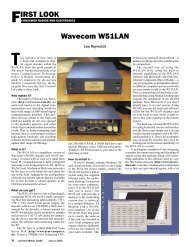MT Express Sample Low Resolution Issue ... - Monitoring Times
MT Express Sample Low Resolution Issue ... - Monitoring Times
MT Express Sample Low Resolution Issue ... - Monitoring Times
You also want an ePaper? Increase the reach of your titles
YUMPU automatically turns print PDFs into web optimized ePapers that Google loves.
This Month’s Interesting Antenna-Related Web site:<br />
This site discusses indoor antennas:<br />
http://www.hard-core-dx.com/nordicdx/<br />
antenna/hidden/indoor.html<br />
will snap onto the fresh 9-volt battery which is<br />
used to power the active antenna. No switch was<br />
included in this design: the circuit was simply<br />
un-snapped from the battery to turn it off.<br />
The transistor can be an MFP-102 (Radio<br />
Shack #276-2062), 2N3819 (Radio Shack<br />
#276-2035), or similar N-channel FET. If you<br />
substitute a P-channel FET then you must reverse<br />
the battery polarity from that shown in the diagram.<br />
Your local Radio Shack, Dan’s Small Parts<br />
and kits, or other radio-parts supply store should<br />
have the required parts.<br />
Make sure all the wires and leads you connect<br />
together are clean. You can scrape them with<br />
a knife edge to clean them if needed. The unit<br />
will probably work more reliably if you solder<br />
the connections, but just twisting the leads of the<br />
parts very tightly together will work if you can’t<br />
solder. A small soldering iron is less likely to<br />
overheat the components.<br />
Carefully connect the parts as shown in fig.<br />
1, and then recheck to see that the circuit is wired<br />
properly. The position on the transistor of the leads<br />
to the source, gate and drain varies for different<br />
transistors, so check this in the data that comes<br />
with your transistor.<br />
The connection to the receiver antenna can<br />
be via coax as shown in fig. 1, or you can use a<br />
pair of wires twisted together to form a short cable.<br />
The wire attached to the capacitor should run to<br />
the center conductor of the antenna input terminal,<br />
and the wire connected to the battery negative<br />
(-) terminal should run to the antenna-connector<br />
ground or shell.<br />
Try lengths of from five to twenty feet or<br />
more for the antenna wire. If it is too long, you may<br />
notice problems with intermodulation distortion or<br />
desensitization when strong signals are present at<br />
your location. If your building shields the antenna<br />
from signals too much for decent reception, try<br />
putting a whip antenna in a window to replace<br />
the antenna wire, hanging the antenna wire out a<br />
window, or attaching the antenna wire to a wire<br />
window-screen.<br />
Happy monitoring!<br />
Last Month<br />
I said: “Let’s say that you are listening on HF,<br />
and you receive a very short transmission, perhaps<br />
just a dit of Morse Code. Then after only a fraction<br />
of a second, say .13 second, you receive that<br />
identical transmission again. Is it possible that the<br />
short transmission wasn’t re-transmitted a second<br />
time, but somehow, instead of traveling off into<br />
space, it returned to your antenna a second time?<br />
Could it even do this a third, or fourth time? Radio<br />
waves travel in straight lines don’t they? So am I<br />
just talking crazy, or could that really happen?”<br />
Well, when propagation is right for it, signals<br />
do actually go around the world in about .13 seconds.<br />
And after doing this they sometimes arrive<br />
back at your station with sufficient strength to<br />
be heard. The antenna pioneer John Kraus has<br />
mentioned that he used his famous bi-directional<br />
W8JK beam to check for round-the-world band<br />
openings by tapping the key, and listening for his<br />
signal to return in this fashion.<br />
Engineers for the radio pioneer, Marconi,<br />
built a very large beam antenna in Australia<br />
for Great Britain’s world-wide communication<br />
system. When using this “Imperial Beam,” radio<br />
operators could actually hear several round-theworld<br />
passages of transmissions which they<br />
sent from that beam: the signals made multiple<br />
round-the-world trips and were heard several<br />
times before they became too weak to be heard!<br />
This Month<br />
Okay, so we can receive a signal a second<br />
time after it goes around the world and comes<br />
back past our location again in about .13 second.<br />
But what about receiving a transmission of our<br />
own voice a few seconds after it was transmitted?<br />
Sounds spooky, huh? Can it happen?<br />
You’ll find an answer to this month’s riddle,<br />
another riddle, another antenna-related web site<br />
or so, and much more, in next month’s issue of<br />
<strong>Monitoring</strong> <strong>Times</strong>. ‘Til then, Peace, DX, and 73.<br />
* MFJ Enterprises, Inc., P.O. Box 494, Mississippi<br />
State, MS 39762. phone: 800 - 647-1800<br />
**Bilal Company, 137 Manchester Drive, Florissant,<br />
CO 80816, phone: 719-687-0650<br />
*** http://www.danssmallpartsandkits.net/<br />
January 2005 MONITORING TIMES 63
















